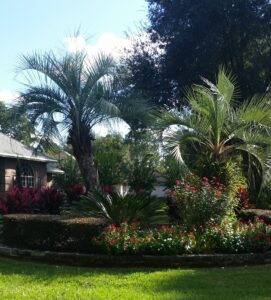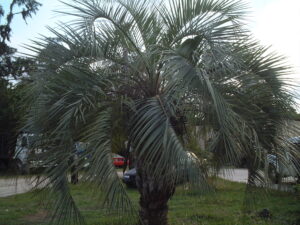Pindo Palm / Jelly Palm
( Butia Capitata )
 Pindo Palm / Jelly Palm Origins:
Pindo Palm / Jelly Palm Origins:
– Butia Capitata is native to Brazil and makes an excellent
ornamental palm specimen for the North Florida / Jacksonville / St. Augustine area commercial and residential landscapes.
– Edible fruits of the Pindo Palm / Jelly Palm are used in the making of
alcoholic drinks and are often used to make jelly giving the palm its common name.
Pindo Palm / Jelly Palm Preferred Exposure:
– Full sun is preferable in the North Florida landscape but Pindo Palm / Jelly
Palm will also tolerate a partial shade and partial sun location without difficulty.
Pindo Palm / Jelly Palm Fronds | Trunk:
– Foliage of the Pindo Palm / Jelly Palm remains evergreen through the winter in the North Florida landscape and is extremely cold tolerant sustaining no winter damage even in the coldest of our local winter seasons.
– One of the most decorative of all the Palms of North Florida, the
Pindo Palm / Jelly Palm has a somewhat large stately head that reaches as much as 10-15 ft from left to right when mature. The fronds are a beautiful silvery gray green color and gently arching towards the ground giving the palm a very graceful appearance.
– Trunks of the Pindo Palm / Jelly Palm are quite large and may reach 2
ft in diameter from left to right.
– Old leaf fronds are resistant to wind damage and remain on the trunks for
prolonged periods of time requiring little pruning to keep the palm looking its best.
Pindo Palm / Jelly Palm Soil Preference / Salt tolerance:
– Butia Capitata / Pindo Palm / Jelly Palms planted in the North
Florida | Jacksonville | St. Augustine landscape will tolerate virtually any soil components, providing they are planted into well drained soils.
– Salt tolerance is moderately high and Pindo Palm / Jelly Palm may be planted on the street side of ocean front properties
Pindo Palm / Jelly Palm Size Variance:
– Although Pindo Palm / Jelly Palms are very slow growing they can
reach sizes of 15-25 feet H | and spreading 10-15 feet in width. Often seen much smaller in the North Florida landscape.
Pindo Palm / Jelly Palm Growth Habit:
– Pindo Palm / Jelly Palm has broad spreading highly decorative foliage and
although slow to develop any trunk height these trees quickly develop 6-8 ft long fronds.
– Ideal for smaller modern neighborhood lawns and landscapes where larger Phoenix family of palms can easily overpower the more narrowed front “curb appeal” area of a home or space.
Pindo Palm / Jelly Palm Growth Rate:
– Like many palm species the Pindo Palm / Jelly Palm is extremely slow growing and may develop only 3-6 inches of trunk each growing season.
– Fronds develop length quickly and within 3-5 years after being planted from the average 30 gallon palm you can expect your trunk to have a 2 ft by 2 ft base and fronds 10 ft or more across from left to right.
Pindo Palm / Jelly Palm Bloom:
– White to yellow flower clusters give way to large yellow date fruits that are commonly used in mixed alcohol drinks or used to make a sweet jelly.
Pindo Palm / Jelly Palm Water Requirements:
– Drought tolerant once established into the landscape. Take care to water well for the first few months after being planted from and S & J Nursery container into the landscape.
Best Uses For Pindo Palm / Jelly Palm in the North Florida | Jacksonville |St. Augustine landscape:
– Pindo Palm / Jelly Palm is an excellent choice for a landscape statement
for smaller frontage more modern yards and gardens or commercial buildings where their highly decorative heads can be fully appreciated as a focal accent of the landscape.
Care of Butia Capitata Pindo Palm / Jelly Palm:
– Pindo Palm / Jelly Palm will need good water during the establishment period and are drought tolerant once established into the landscape.
– Slow growth and damage resistant fronds make Pindo Palm / Jelly Palm a low maintenance palm selection. Although pruning is seldom necessary, trim back any older browned out fronds as needed at the base of the stem to keep the plant at its best.
MINIMUM PALM FERTILIZER REGIMEN – what you should be doing to keep your palm healthy
– Fertilize each spring with a specially blended fertilizer for Palms, follow
manufacturers directions and apply 1/2 lb o 1lb of fertilizer per inch of diameter of trunk on your palm, measured from a hands width above the ground level. That means for a 12 inch wide trunk from left to right you
would need 6-12 lbs of fertilizer for just that one palm!
– Fertilize every fall with magnesium sulfate ( Epsom Salt) to keep your palm green and healthy through the winter months!
MAXIMUM PALM FERTILIZER REGIMEN – what you can do to get your palm up and growing Fast!
– Fertilize every three months with your choice of Palm fertilizer and
Magnesium Sulfate. Water 3-4 times per week and make sure to water thoroughly after each fertilizer application.
– Wait till fronds have turned completely brown before removing from the palm as the palm will take back in the nutrients from those older leaves ad use it when forming new ones.
*CAUTION – DO NOT FERTILIZE NEWLY PLANTED
/ TRANSPLANTED
FIELD GROWN PALM TREES WITH PALM
FOOD!
Note : When planting smaller palms being grown in a container, this rule does not apply, rather, use half the recommended application rate for your trunks diameter, as containered palms roots have not been damaged or cut during planting but are still only a portion as large as they would be if the palm had been growing in the ground and excess fertilizer on a confined root system is still not preferable for maximum health.
Palm fertilizers are water soluble and will burn the new roots your palm tree is trying to put out as it establishes itself into the landscape. It is best to use only poly coated plant food that is heat release like Osmocote general purpose fertilizer or non burning Milorganite in the first year in the landscape, and then the following year, start your palm food regimen that will provide all of the minor nutrients that your palms will need to keep them healthy and problem free in Florida’s soils.

